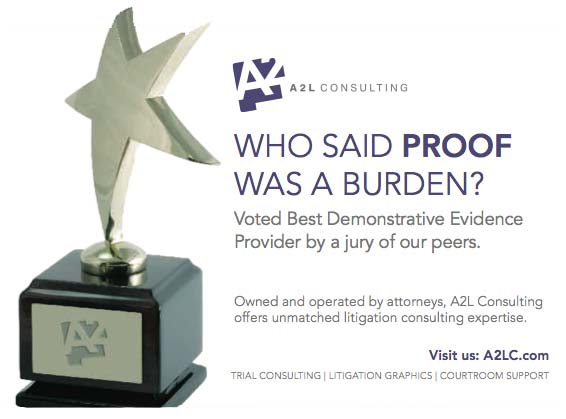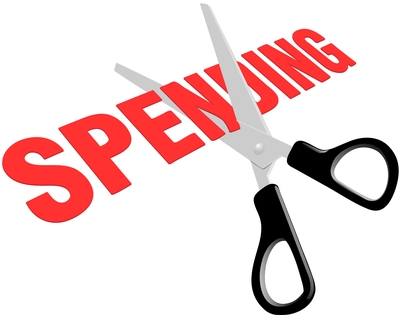by Theresa D. Villanueva, Esq.
Director, Litigation Consulting
A2L Consulting
It is undisputed that trial graphics, trial technology and working with trial consultants & litigation graphics specialists give the modern litigator an edge when walking into the courtroom. This is true for many reasons. First, today’s juror expects some type of interactive presentation, whether it is a legal animation or demonstrative exhibits. Second, trial consultants can step into the case with a fresh set of eye’s and perspective, and can provide valuable insights into the key themes that the team has identified and even sometimes pointing out themes or ideas the team has not thought of.
In today’s economic climate litigation support consulting companies have seen a shift towards a more economical approach towards litigation. Law firms and their clients (from large firms to solo practitioners) are looking to keep trial costs under control. With many different options and approaches to trial presentation graphics and trial technology available today, lawyers and their client’s can still head to trial armed with these essential tools.
Let’s take a look at 9 ways you can use trial presentation graphics and trial technology while managing costs.
1. Focus on Key Trial Themes and a Simple Narrative
One way to keep trial graphics costs low is to choose a small number of important themes that you want to emphasize and that you want the jury to pay particular attention to. By focusing on these key themes, you can limit the number of trial graphics to be created. Utilized effectively you can make a significant impact with even just one or two demonstrative exhibits.
The key here is to utilize your Trial Consultant to narrow the scope of what trial graphics will be created. This will eliminate the creation of unnecessary graphics and streamline the development process.
See Using a Two-Track Trial Strategy (trial presentation + a solid appeal record) to Win
2. Use Printed Trial Boards and Blow-ups
Using boards in lieu of electronic presentations is a great way to save on costs, and it is still by all standards a highly effective presentation method. With the introduction of PowerPoint 2003, trial graphics became more advanced and began to move in the direction of electronic presentations. However, over the last couple years, the pendulum has swung back in the direction of using trial boards. Today, it is not uncommon to see a mix of boards and electronic presentation. Boards are a great way to use trial presentation graphics on a lower budget. Another bonus of using boards is the savvy litigator can sometimes find a way to leave the board up throughout trial keeping their message consistently in front of the Judge or Jury.
See Printed Trial Boards Making a Comeback
3. Receive Training on Presentation Software (e.g. TrialDirector, Sanction or an iPad app)
Having a trial technician on-site is always favored, but the reality is that it is not always feasible from a budgetary standpoint. One of the great things about trial presentation software is it is user friendly. For a shorter or smaller engagement the presenter or another team member can receive training from an experienced Trial Technician to learn the basics.
Certain situations in which this might be a budget friendly alternative include: shorter trials, smaller document databases, trial databases that contain no deposition video or databases that will not require a lot of last minute changes or video editing.
See [Free E-Book] Finding the Best Trial Technician for Your Case
4. Limit Your Trial Database to Key Documents
Similar to developing key demonstrative exhibits, we can build a database of the key documents you plan to use - whether it is for cross, a particular witness or documents that are crucial to your case. Sometimes using the Elmo just doesn’t have the same impact as having the flexibility and technological advantage of using presentation software such as Trial Director or Sanction.
See How Indata's TrialDirector Makes Litigators Look Like Stars
5. Have Your Deposition Video Edited and Burned to a DVD
If video is all you need, and editing clips can be done in advance, playing them on a DVD in court is a great budget saver. In a recent case, I had a client that was on a very tight budget but still needed to play some video deposition clips at trial. They really wanted to have a Trial Technician or use Trial Director but cost was a major concern. We discussed several different options including the option to edit the clips in trial director and export the clips onto a DVD they could play through their own computer at trial. This was a great solution all around. We still had the flexibility of editing in Trial Director, and the client ended up with a budget friendly way to show their video.
See Using Video Depositions in the Best Way at Trial
6. Streamline Your Trial Presentation
When trial presentation graphics are needed but budget is limited, you may be faced with the question of where do I need trial graphics the most? Is there an expert witness with a difficult concept to explain? Do you need litigation graphics to counter the opposing expert’s testimony? Perhaps you feel that opening or closing statement is where you need to make the biggest impression with the judge or jury. If you know there is one area that is the core of your case, focusing a set of demonstrative exhibits here not only can not only save on cost it can also add value to your case.
See [Free eBook] The BIG Litigation Interactive E-Book
7. Create Your Own PowerPoint and Use Litigation Graphics Consultants to “Polish” the Work
Just as your hairdresser would not recommend cutting your own hair, generally, we do not encourage our clients to create their own PowerPoint presentations. There is just too much at risk and things can quickly go awry. However, if cost is a major concern, creating your own PowerPoint and asking for help can be an economical option. Once you layout out the basics of your presentation one of our consultants will work with you to enhance the presentation. From something as simple to creating a new template, formatting each slide for uniformity, or even adding some animation sequences. These, among other tricks can add a solid finish and give your slides the polished look they need.
See [Free eBook] The Trial Team's Guide to Creating Great Timelines for the Courtroom
8. Have a Trial Tech on Certain Key Trial Days
In many instances it is essential to have a Trial Technician on-site with the team, but the team just does not have the budget for a trial tech to be on-site for the duration of the trial. Perhaps there is one witness that will truly benefit from the interaction of using an electronic presentation, or maybe there is an opposing witness you know you can impeach with video clips from their deposition. On these occasions having a trial technician there only for certain stages of the trial can be a huge cost savings for the budget conscious team, while still benefitting from a Trial Tech’s expertise.
See Free Guide to Finding and Engaging the Best Trial Technicians
9. Keep Litigation Graphics Simple - No Courtroom Animation
One of the cost drivers in the creation of demonstrative exhibits can be the addition of animation – or making a piece of the graphic move. Some animation such as “building” in certain elements is very simple and does not necessarily drive cost up. However, complex animation can be very time consuming, require more edits and can lead to higher costs. One way to avoid this is to have Litigation graphics with little to no animation. It is very easy to get caught up in the idea of using legal animations in presenting your case, but a non-animated trial graphic can have just as much of an impact on your audience.
See A2L's Complimentary Biggest and Best E-Book for Trial Attorneys
If cost is a concern, demonstrative exhibits and trial technology no longer have to be the first items to scratch off your list – you simply need to work with the right trial consulting firm who will find the best solution for your team and budget.








Leave a Comment